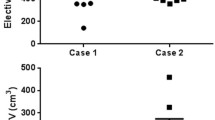Aim:
To evaluate the impact of interobserver variability in the contouring of gross tumor volumes (GTVs) and clinical target volumes (CTVs) on the global geometric accuracy in radiation therapy.
Material and Methods: In a review of the currently available literature, the magnitude of interobserver variability is analyzed, causes and consequences are discussed. Uncertainties due to inconsistencies in contouring are related to other sources of geometric errors, particularly patient positioning and organ motion.
Results: Interobserver variability is a major – for some tumor locations probably the largest – factor contributing to geometric inaccuracy. Causes are multifactorial and include image- and observer-related factors, such as the subjective interpretation of image information.
Conclusion: Consequences to reduce interobserver variability are proposed, among others the selection of adequate imaging modalities, intensified radiologic training, and the use of telecommunication tools.
Ziel:
Analyse er Bedeutung der Untersucher-Variabilität bei der Zielvolumendefinition für die Präzision der Strahlenbehandlung.
Material und Methoden: Anhand einer Literaturübersicht wird die Größenordnung der Untersucher-Variabilität dargestellt, Ursachen und Konsequenzen werden diskutiert. Die Untersucher-Variabilität wird mit anderen Ursachen geometrischer Ungenauigkeiten verglichen, insbesondere der Lagerungsungenauigkeit und der Organbewegung.
Ergebnisse: Die Untersucher-Variabilität ist ein bedeutender, für einige Tumorlokalisationen vielleicht der größte Faktor, der die geometrische Präzision beeinflusst. Die Ursachen sind multifaktoriell und beinhalten sowohl bild- als auch untersucherbezogene Faktoren, z. B. die subjektive Interpretation von Bildinformationen.
Schlussfolgerung: Möglichkeiten zur Reduktion der Interobserver-Variabilität werden dargestellt, u. a. die Auswahl geeigneter Bildgebung, gezieltes radiologisches Training und der Einsatz moderner Telekommunikationsmethoden.
Similar content being viewed by others
Author information
Authors and Affiliations
Additional information
Received: December 3, 2001; accepted: August 2, 2002
Correspondence Address Elisabeth Weiss, MD, Klinik und Poliklinik für Strahlentherapie, Universität Göttingen, Robert-Koch-Straße 40, 37075 Göttingen, Germany, Phone (+49/551) 39-8845, Fax -12614, e-mail: eweiss@gwdg.de
Rights and permissions
About this article
Cite this article
Weiss, E., Hess, C. The Impact of Gross Tumor Volume (GTV) and Clinical Target Volume (CTV) Definition on the Total Accuracy in Radiotherapy . Strahlenther Onkol 179, 21–30 (2003). https://doi.org/10.1007/s00066-003-0976-5
Issue Date:
DOI: https://doi.org/10.1007/s00066-003-0976-5




